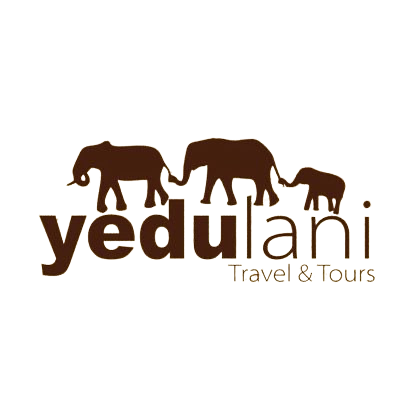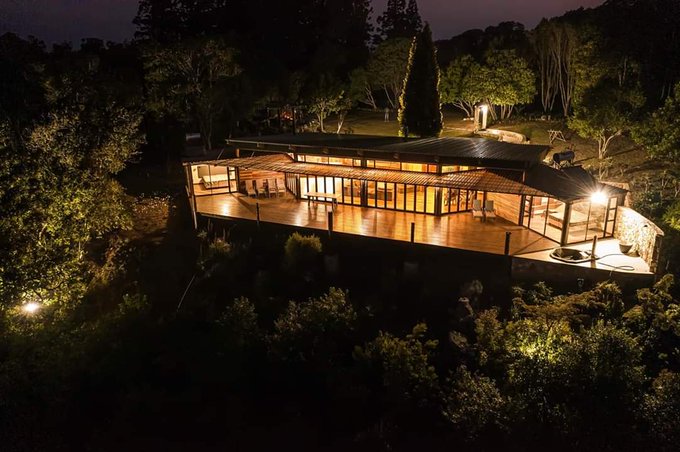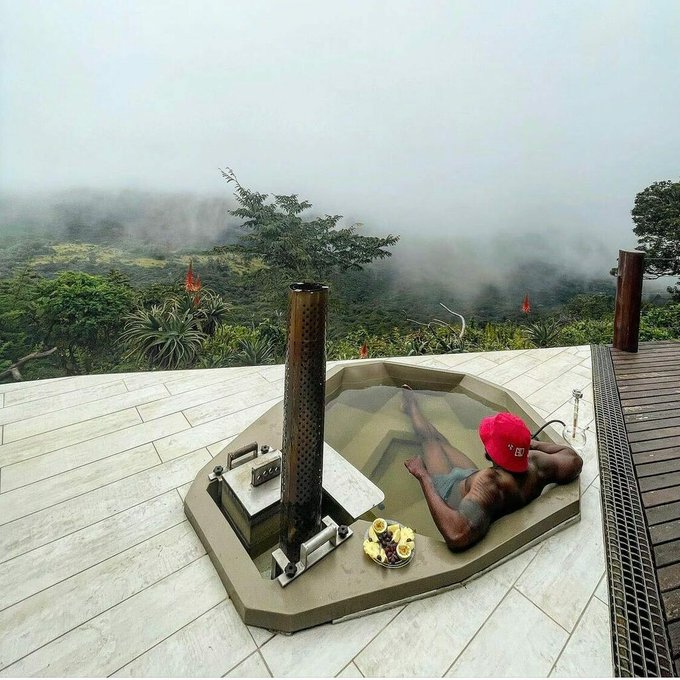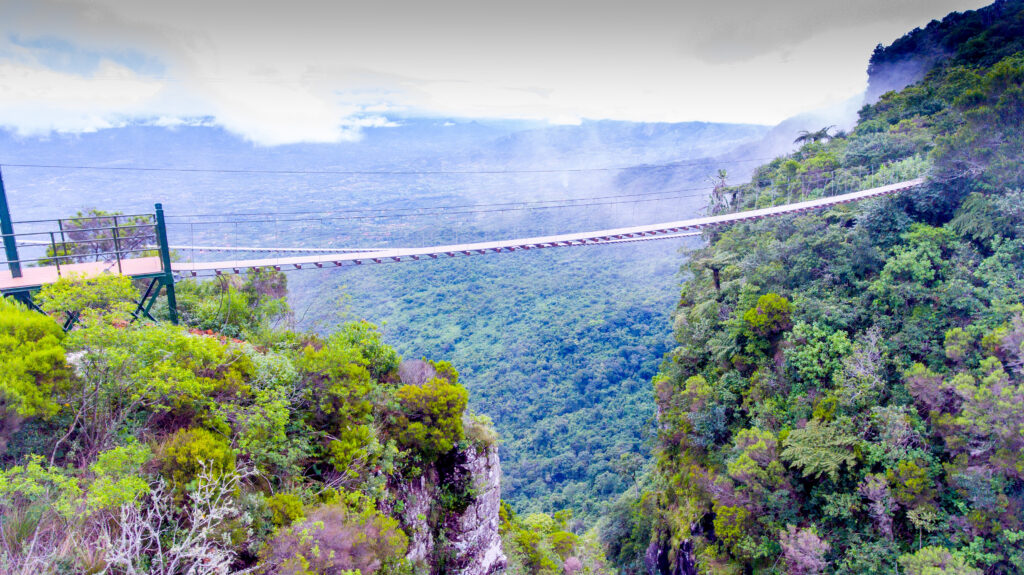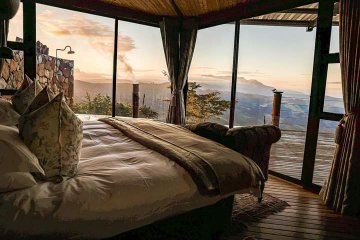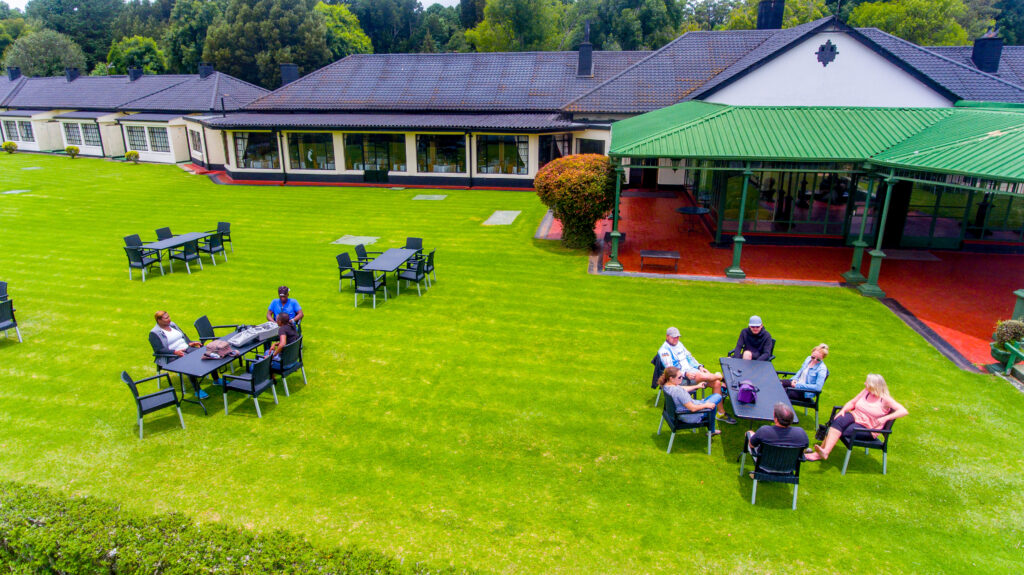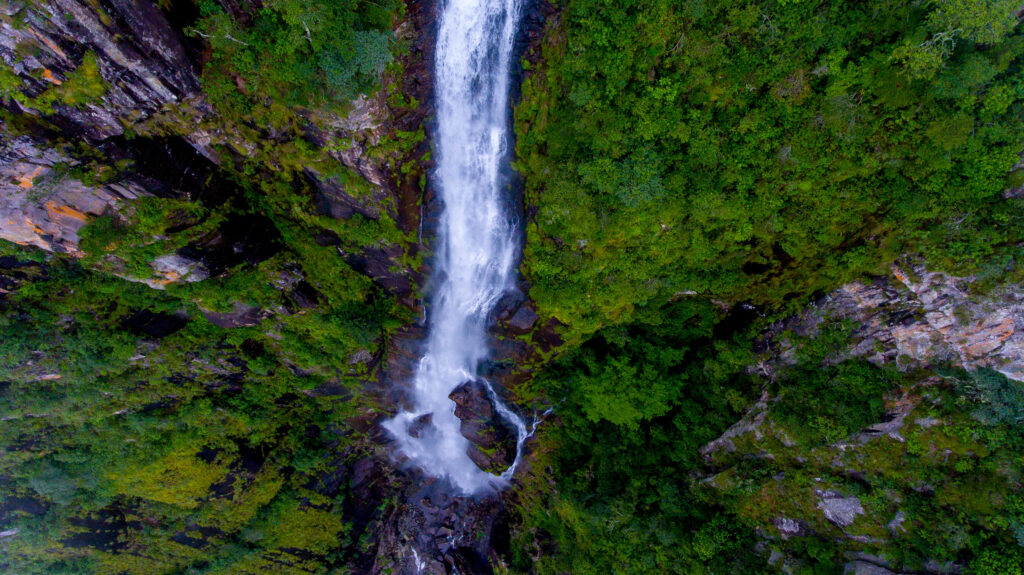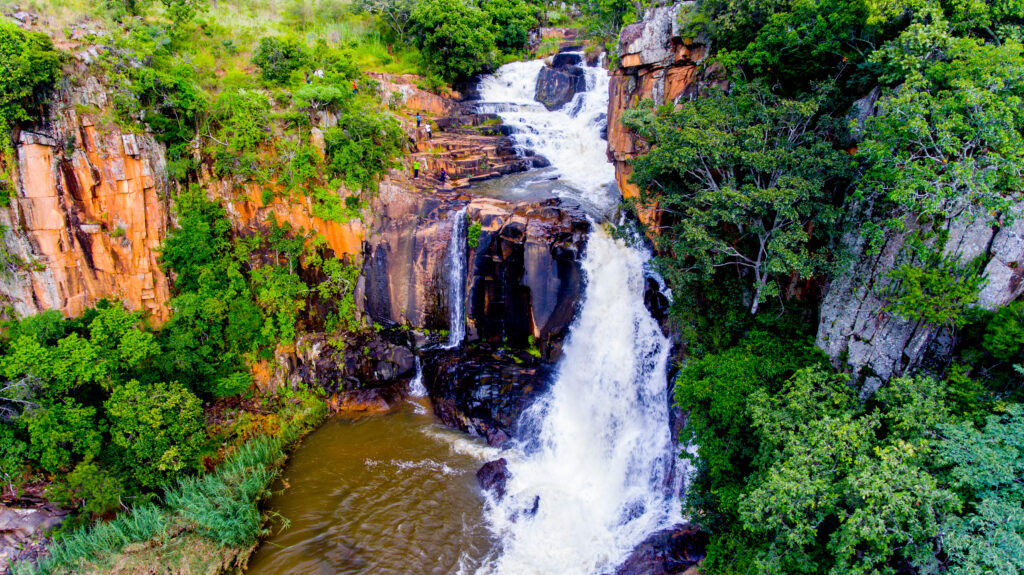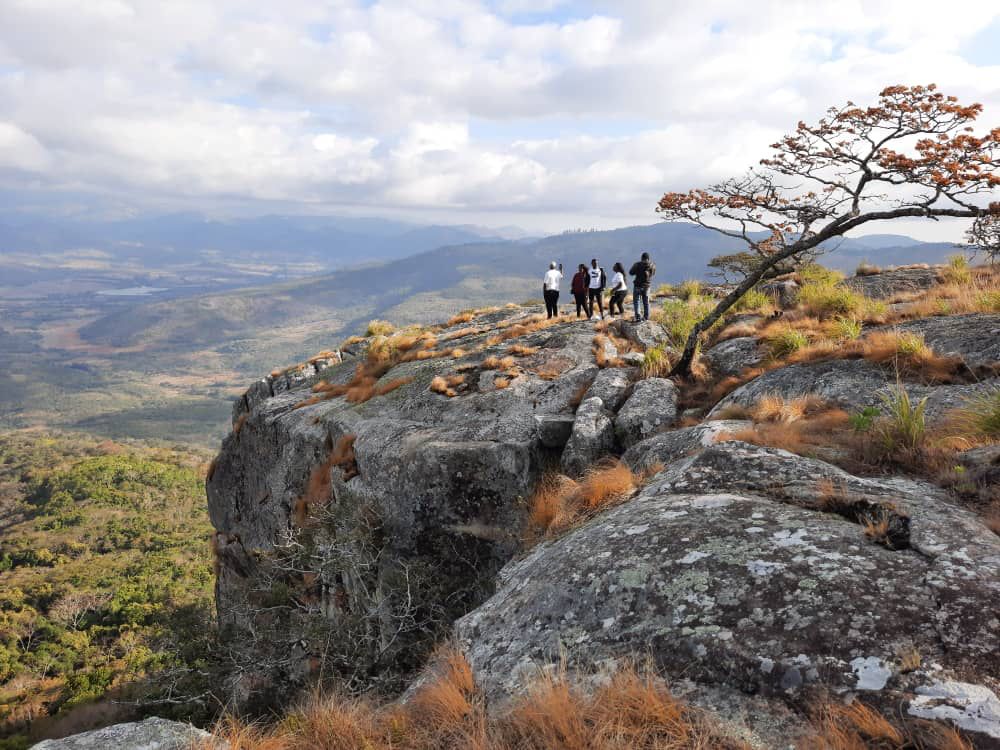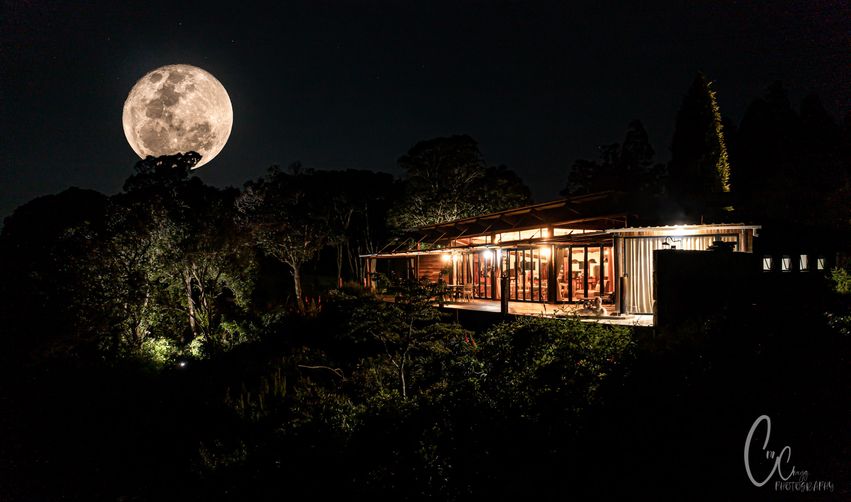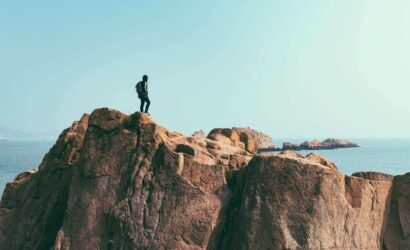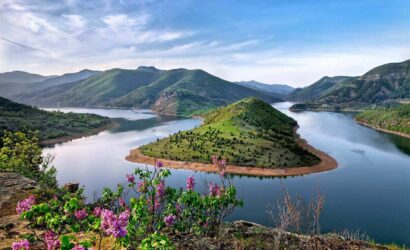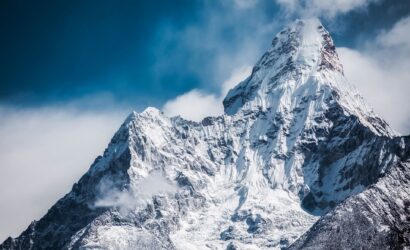The Eastern Highlands is made up of three areas – the Nyanga Highlands in the north, the Bvumba Mountains in the center and the Chimanimani Mountains in the south – each of which has its own attractions. In the rolling hills of the north, Nyanga National Park is where you’ll find Zimbabwe’s highest mountain, Mount Nyangani, and its highest waterfall, Mtazari Falls as well as wildlife, lots of birds, wonderful hiking trails and excellent trout fishing. The central highlands are home to the city of Mutare – the biggest settlement in the region – but the real draw is the Bvumba Mountains, where lush forests are home to rare bird species and the samango monkey. In the southern highlands, Chimanimani National Park is excellent for mountain hiking, while you can indulge in some forest therapy at Chirinda Forest Reserve, Africa’s most southern tropical rainforest, and go horseback riding in the hills.
Overview of the Eastern Highlands
Eastern Highlands, a gem in the Southern African continent, sets an image of unspoiled beauty in my mind. Bounded by rolling mountain ranges, verdant valleys, and dazzling cascades, it’s a canvas of nature’s best strokes. Dressed in various shades of nature, from the deepest greens to sparkling blues, the area’s ethereal beauty makes it a dream destination.
Biodiversity takes centerstage, offering a vibrant dance between floral elegance and faunal grandeur. From the lilac-breasted roller with its vibrant plumage to the Cape buffalo’s imposing presence, there’s always something that captivates my sight. The land also nestles itself in the embrace of impressive history and rich culture, defining its integral makeup.
Outdoor enthusiasts find their piece of paradise as hiking trails wind through mountains, picnic spots dot river banks, and bird watching locations beckon the eager observer. Whether it’s the rush of adrenaline when I’m on an adventure or the tranquility that comes with immersing myself in nature, Eastern Highlands encapsulates the essence of travel escapades for me.
Location and Geography
Strategically nestled in the Eastern side of Zimbabwe, the Eastern Highlands form a serpentine range extending over 300 kilometers. It starts in the North with Nyanga National Park and wraps itself down to the South where it meets Chimanimani National Park. This emerald stretch serves as the backbone of Zimbabwe, adding to its unmistakable charm.
Bearing witness to eons of weathering and geographical transformations, the Highlands jump between altitudes of 500 to 2,593 meters. This region is a riotous blend of rugged mountains, fast-flowing rivers, and placid lakes. Transcending limits of the geography textbook, it moulds itself into a live outdoor classroom where I get to encounter and experience the intricacies of earth’s physical features firsthand.
Natural Wonders and Landscapes
Veering away from the mundane, the Eastern Highlands provides visitors an abundance of spectacles to behold. Encased within the region’s highlands and mountainous areas, vibrant ecosystems bustle with life, creating an unmatched synergy of natural wonders across Zimbabwe’s Eastern Highlands.
The Bvumba Mountains
As part of the Eastern Highlands, the Bvumba Mountains stand as a testament to the area’s natural beauty.
Scenic Vistas and Hiking Trails
From misty mornings to serene sunsets, the vistas offered from the trails of the Bvumba Mountains are nothing short of breathtaking. For instance, the famous Leopard Rock presents panoramic views, its trails leading you through captivating landscapes that radiate tranquillity.
Rainforests and Waterfalls
It’s in the heart of the mountains that you’ll find Madagascar-style rainforests, pocketed with endemic species. Bvumba Botanical Gardens and Reserve is home to a myriad of waterfalls, like the cascading Bridal Veil Falls, illustrating the depth of biodiversity contained within this rainforest ecosystem.
Nyanga National Park
Overshadowing the northern part of the Eastern Highlands, Nyanga National Park forms a haven for the region’s indigenous species.
Montane Grasslands and Evergreen Forests
Nyanga’s geography showcases montane grasslands and dense evergreen forests, with Mount Nyangani—Zimbabwe’s highest peak—as its key feature. The Pungwe Falls and Pungwe Gorge, meandering through the park, offer soothing sounds of runnels that reinvigorate the senses.
Unique Flora and Fauna
Nyanga National Park encompasses abundant flora and fauna. Sightings of blue duikers, bush pigs, and the rare Samango monkeys pepper the park’s wilderness. For bird enthusiasts, the park’s repertoire includes the critically endangered Blue Swallow, embellishing Nyanga’s biodiversity tapestry.
Other Natural Features
Beyond the mountains and national parks, the Eastern Highlands further surprises with nature’s unexpected gifts.
Rhodes’ Nyanga Estate
Preserving the memory of Cecil John Rhodes, Rhodes’ Nyanga Estate nestles historical artifacts amidst expansive gardens and ancient trees. Here, history merges with nature, creating a unique space for the Eastern Highland’s visitors.
Hot Springs and Mineral Spas
Imbibing the earth’s therapeutic minerals, bubbling hot springs and mineral spas like the ones in Osborne Dam attract those looking for restorative experiences. These natural hot baths, simmering against Zimbabwe’s natural backdrop, encapsulate how the Eastern Highlands’ landscapes offer more than just beauty—it’s a source of holistic rejuvenation too.
Outdoor Adventures and Activities
As we delve deeper into the captivating tapestry of Eastern Highlands, Zimbabwe, a plethora of outdoor activities awaits every adventurous soul. Whether it’s hiking, mountain biking, fishing, or birdwatching, these highlands are a natural playground, brimming with untamed beauty and thrilling exploration opportunities. Let’s explore each avenue in detail.
Hiking and Trekking
Hiking and trekking paths in Eastern Highlands, Zimbabwe, crisscross the scenic landscapes, inviting a closer connection with nature. Known for its stunning vistas, the region is a haven for walkers and hikers, promising solitude amid verdant settings.
Trails and Routes in Bvumba and Nyanga
Scenic routes in Bvumba privide the chance to explore the exotic beauty of Leopard Rock, while the trails in Nyanga present breathtaking views of its montane grasslands. The paths range from gentle walks for novices to challenging treks for seasoned hikers, catering to a wide range of fitness levels and hiking abilities.
Guided Hikes and Nature Walks
Guided hikes and nature walks are a favored method of exploring the Eastern Highlands. These tours offer expert guidance in identifying diverse flora and fauna indigenous to the area, cultivating an enriching understanding of Zimbabwe’s unique biodiversity.
Mountain Biking
For adrenaline seekers, the Eastern Highlands feature numerous mountain biking trails. Topographically diverse, these routes provide elevation changes, challenging terrains, and thrilling descents. The feeling of cycling through the lush canopy, accompanied by the symphony of chirping birds and rustling leaves, is intoxicating.
Fishing and Trout Streams
The Eastern Highlands serve as ideal fishing grounds, boasting serene streams bountiful with Trout. Anglers, from novices to skilled fishermen, are drawn to the peaceful, idyllic landscapes where they can cast their lines and enjoy the tranquil surroundings.
Birdwatching
A rich array of bird species thrive in the Eastern Highlands, making it a prime destination for birdwatchers. From common species to rare and exotic birds, the region’s forested areas and grasslands are a hub of avian diversity. This surfeit of feathered inhabitants presents an unending spectacle for bird lovers, making the Eastern Highlands an ornithologist’s paradise.
Historical and Cultural Attractions
After the exciting ventures in the wild expanses of Zimbabwe’s Eastern Highlands, it’s time for a rich cultural immersion. This section uncovers the historical and cultural attractions embedded in the Highlands, representing the nation’s distinct heritage.
World’s View and Other Scenic Viewpoints
World’s View, also popularly known as Nyanga viewpoint, offers breathtaking vistas. Overlooking the lush green mountains range, it boasts one of the best 360-degree panoramic views in Zimbabwe. Besides World’s View, Mutarazi Falls provides an awe-inspiring sight. As the highest waterfall in Zimbabwe, it drops from an astonishing height of 762 meters.
Archaeological Sites
For history buffs, there’s nothing like the mystery of archaeological sites. Zimbabwe’s Eastern Highlands hosts a number of them. Pit Structures in Nyanga, castle-like terraces carved into rocky hilltops, bear testament to the region’s prehistoric civilizations. Zimbabwe’s oldest archaeological site, Ziwa Ruins in Nyanga, dates back to the early Iron Age, showcasing a rich timeline of human civilization in the region.
Local Artisanal Crafts and Curio Shops
One unique aspect of Zimbabwean culture is its beautiful artisanal crafts. In the Eastern Highlands, various curio shops and markets showcase this handcrafted art. Mutare, the region’s largest city, hosts a vibrant marketplace featuring unique Zimbabwean curios and handcrafted items. From intricate wood carvings to delicate woven creations, these items offer a peek into the tradition of local craftsmanship.
Cultural Tours and Experiences
Cultural tours offer an authentic and engaging way to understand the customs and traditions of Zimbabwe’s Eastern Highlands. Visitors often participate in village visits, meeting local people to enhance their cultural and historical understanding. The unique combination of nature and culture presents an enriching experience in this Zimbabwean region.
Accommodation Options
Accommodations in the Eastern Highlands of Zimbabwe range from luxury lodges to self-catering cottages. Travelers will find options that cater to every budget and preference, ensuring everyone experiences the comfort needed while exploring this unique region.
Hotels and Resorts
Ample hotels and resorts serve the Eastern Highlands. They provide a plethora of amenities, making the stay peaceful and enjoyable. For instance, the Inn on the Vumba merges comfort and nature into a solitary experience.
Bvumba and Nyanga Areas
In Bvumba and Nyanga, travelers find high-end resorts offering breathtaking views. Leopard Rock Hotel in Bvumba and Rhodes Nyanga Hotel in the Nyanga region are notable examples. They offer well-appointed rooms complemented by spectacular surroundings.
Luxury Lodges
Luxury lodges provide a special treat for those seeking an extravagant stay. The Pine Tree Inn, found amidst the beauty of Bvumba, promises an opulent experience.
Self-Catering and Cottages
For a homely flavor, self-catering accommodation options and cottages are available. These offer a personal and cozy lodging experience. Examples include Far and Wide Zimbabwe in Nyanga and Seldomseen Cottages in Bvumba.
Camping and Caravan Parks
Travelers preferring a closer connection to nature can opt for camping and caravan parks. Terkhiin Tsagaan Lake Campsite and Far and Wide Zimbabwe are well-equipped spots to pitch a tent.
Nearby Towns and Facilities
For added convenience, nearby towns like Mutare offer multiple facilities, including supermarkets, banks, and medical services. Mutare boasts high-quality hotels like the Holiday Inn for those preferring urban accommodations. These towns allow access to both the culture of the Eastern Highlands and the comforts of city living.
Getting to the Eastern Highlands
By Road
Arriving in the Eastern Highlands by road offers scenic views and an adventurous journey.
Self-Drive Routes
Self-drive routes pose an exciting opportunity for road-tripping, allowing travelers to take in the panoramic landscapes at their own pace. The usual route for most coming from Harare involves the A3 and A14 highways. The A3 takes you out of Harare, providing a mostly straight travel path eastward towards Mutare. From Mutare, the A14 takes you through the heart of the Eastern Highlands region, connecting to many of the highlight locations, such as the Vumba Mountains and Nyanga National Park.
Shuttle Services
For those preferring more convenience, various shuttle services operate within Zimbabwe. These services cover major routes reaching the Eastern Highlands from cities such as Harare and Bulawayo. With them, you have the relaxation of a road journey without having to steer for countless hours.
Tour Packages
Tour packages present a hassle-free option for exploring the Eastern Highlands. Several tour operators in Zimbabwe provide well-curated itineraries that include transport, activities, and lodgings. You can opt for regular or customized packages, depending on your preferred style of travel. The inclusion of transportation means that these tours simplify the logistics of getting to and around the Eastern Highlands.
Nearest Airports and Transfers
Closest in proximity to Eastern Highlands, you’ll have the Harare International Airport, and Joshua Mqabuko Nkomo International Airport in Bulawayo. Flights from major regional and international cities land at these airports. From these airports, you can use ground transfer options such as car rentals or shuttle services to reach the Eastern Highlands.
Keep in mind, direct flights to Harare are often more readily available compared to Bulawayo. Consequently, Harare serves as a more common arrival point for many international travelers. From there, the picturesque road journey to the Eastern Highlands lasts about 3-4 hours, depending, of course, on individual travel speed and pit stops.
Best Times to Visit
Furthering your Eastern Highlands (Zimbabwe) adventure, discretion calls for understanding the best times to schedule your visit. Depending on your preference for the climate and the experiences you seek, different seasons will suit different visitors. Delving into seasonal variations, specific weather and climate considerations, and noteworthy events and festivals will provide insights to aid your planning.
Seasonal Variations
Dry Season
Falling between May and October, the dry season in Zimbabwe’s Eastern Highlands bears milder temperatures of 15 degrees Celsius on average. This season witnesses less rainfall, unveiling unobstructed views of the landscape, making it an ideal time for outdoor activities. The reduced flow in rivers facilitates fishing and canoeing with are more predictable water levels. A hike up to the World’s View, Mutarazi Falls or the Pit Structures brings an unforgettable experience of the mystic highlands under clear, blue skies.
Wet Season
The wet season, usually extending from November to April, presents the Eastern Highlands bathed in the vibrant greens. The rain showers rejuvenate the lands, breathing life into the wildlife and the floral wonders. Though hikes may demand a higher level of caution during rains, the view of valleys cloaked in mist has its own enchanting appeal. The wet season also beckons bird watchers, drawing a multitude of migratory species, adding a riot of colors to the sky.
Weather and Climate Considerations
Beyond seasonal variations, extra care goes into considering the weather and climate of the region for arranging your trip. The altitude of the Eastern Highlands results in cooler temperatures compared to the lower lying regions of Zimbabwe, with averages ranging from 11 to 20 degrees Celsius year-round. Layered clothing proves helpful to accommodate the cool mornings and nights while maintaining comfort during the warmer afternoons. The overall weather remains pleasant, becoming a year-round destination for visitors seeking to escape from intense heat.
Special Events and Festivals
Apart from the natural allure, various events and festivals form an integral part of your visit to the Eastern Highlands. The Bvumba Fair in June showcases local crafts and delicacies and provides a delightful shopping experience. Handicrafts and baked goods, alongside fresh organic produce, form the stars of the show. Another significant occasion, the annual Zimbabwe Tourism Expo, held in Harare, usually in the month of October, exhibits the robust tourism offerings of Zimbabwe, including the Eastern Highlands, and could potentially inflate the number of visitors in the region during that time.
Practical Information
Getting the most from a visit to Zimbabwe’s Eastern Highlands starts with smart preparation. These practical details cover everything from entry costs to safety concerns, packing essentials, and health recommendations.
Entry Fees and Permits
Plan your adventures without concern for any surprise expenses. The main destinations in the Eastern Highlands require entrance fees. For example, the National Parks like Nyanga and Vumba, demand a small entrance fee, with exact amounts varying depending on foreign or local residency status and other factors. Additionally, activities like fishing in certain rivers or dams may need permits. Consider checking the Zimbabwe Parks and Wildlife Management Authority’s (ZPWMA) website for precise, up-to-date information on fees and permits.
Safety and Security
I’ve found the Eastern Highlands to offer a generally safe environment for travelers. However, always maintain vigilance, particularly regarding personal belongings, in busy areas. Nighttime travel may not be advisable due to wildlife and poorly lit roads. Most attractions provide guides or security personnel for added safety while participating in outdoor activities. Contact the nearest tourist information center in cities like Mutare for detailed, current information.
Packing and Gear
When packing for your trip, remember that temperatures in the highlands can drop significantly, necessitating warm clothing. As substantial rainfall occurs in the wet season, pack waterproof jackets and shoes. Getting full enjoyment from outdoor activities like hiking and birdwatching calls for binoculars, sturdy boots, and fast-drying clothing. Camping enthusiasts often bring their equipment, though most sites offer equipment rental.
Health and Vaccinations
A vacation can be quickly ruined by health concerns. Zimbabwe, as a tropical country, insists upon certain health precautions. Ensure you’re protected against malaria, particularly if you’re venturing outside the Highlands. Many travelers are advised to have vaccinations for Hepatitis A, Typhoid, Tetanus, and Diphtheria. Always consult your healthcare provider for personalized advice. Also, pack essential medicine and a first-aid kit, as pharmacies in rural areas are sparse. For peace of mind, invest in travel insurance that covers medical evacuation.
Food and Drink Scene
Local Cuisine and Specialty Dishes
The food journey in the Eastern Highlands bears witness to a rich culinary tradition. The local cuisine mainly relies on locally sourced products. Popular staples such as sadza, a hearty cornmeal porridge, often feature on the dining table. Alongside this, meat and vegetable stews such as beef stew and chomolia, a type of collard greens, also hold their places firm. Due to their popularity, meals frequently accompany these kinds of dishes. Besides these, local fruits like sweet wild loquat, ber, and baobab fruit make a refreshing change.
Tea and Coffee Plantations
Next, it’s time to savor the flavors of the magnificent, sprawling tea and coffee plantations in the region. The eastern part of Zimbabwe is particularly known for its tea and coffee production, courtesy of the fertile volcanic soils and favorable climate. Tourists often visit these lush plantations for a deeper understanding of the production process, taking tea and coffee tours. In such tours, guests get an opportunity to witness the journey that their cup of tea or coffee has made, offering an enlightening experience.
Restaurants and Cafés
After the stimulating plantation tours, it’s time to unwind at some of the delightful restaurants and cafés dotting the Eastern Highlands. The flavor burst of Zimbabwean cuisine and a range of international cuisines fuse seamlessly at these dining establishments. Creations by adept chefs cater to different palates, be it traditional Zimbabwean dishes or continental options. The cafés, with their comfortable settings and scintillating aromas of coffee from the local plantations, offer respite after an exhausting day of exploration.
Wineries and Breweries
For enthusiasts of fermented flavors, the Eastern Highlands has some delightful wineries and breweries, foraying into the realm of fine wines and artisan brews. Depending on personal preferences, visitors can choose to tour these establishments. It’s an enriching opportunity to understand the process of crafting wines and beers. Most guided tours of these establishments ensure guests get to sample some tantalizingly tasteful libations – a perfect end to a food and drink tour of Zimbabwe’s Eastern highlands.
Beyond the Eastern Highlands
The Eastern Highlands’ experience stretches beyond its stunning landscapes, adventurous trails, and delectable cuisines. This section, consequently, explores towns like Mutare in proximity, the bordering Mozambique regions, and nationwide parks and reserves that amplify Zimbabwe’s allure.
Mutare and Other Nearby Towns
Just beyond the breathe-taking Eastern Highlands, I find Mutare, the city often hailed as Zimbabwe’s gateway. Brimming with museums, botanical gardens, and markets—Mutare provides a glimpse into Zimbabwe’s rich history, culture, and community daily life. For instance, the Mutare Museum paints a vivid picture of the country’s colonial past, while the Mutare Botanical Gardens showcases different types of indigenous and exotic plants.
Mutare shares the stage with nearby intimate towns like Rusape and Chipinge. Rusape, renowned for its relaxing ambiance and friendly people, adds another dimension to your Zimbabwean journey. Chipinge, best known for its tea estates and production, invites patrons to explore its verdant fields and tastefully sip the fruits of its labor.
Mozambique Border and Coastal Areas
Talk of tourism in Zimbabwe isn’t complete without the winds of the Indian Ocean sweeping across the land. Visitors often move eastwards from the Highlands, cross Zimbabwe’s border to explore Mozambique’s coastal offerings. Pemba and Maputo, known for their pristine beaches and vibrant nightlife, serve as popular destination choices. Imagine basking in the warm sun and letting the coast’s cultural beat guide your feet during the evening—an experience to treasure.
Other National Parks and Reserves
Zimbabwe houses several national parks and reserves cataloging the region’s rich biodiversity and functioning as critical conservation areas. Apart from the Eastern Highland’s reserves, Matobo National Park comes highly recommended. It sprawls over vast granite landscapes, adorned with ancient rock paintings—a testament to the region’s historical heritage.
Hwange National Park makes another compelling case. As Zimbabwe’s largest park, it houses over 100 mammal species, 400 bird species, rendering an exotic spectacle for wildlife enthusiasts.
With this mosaic of experiences, it becomes apparent that exploring Zimbabwe begins at the Eastern Highlands, but by no measure does it end there. Treasures await around every corner, framing a vacation that’s more an exploration and less a tour.
Tips and Recommendations
After exploring Zimbabwe’s Eastern Highlands, sharing some practical recommendations seems in order. Let’s turn our attention to photography tips, recommended guides and operators, souvenirs and local crafts, and additional resources to make the most out of your trip.
Photography Tips
Capturing stunning vistas of the Eastern Highlands, photography enthusiasts grasp opportunities for standout shots.
- Consider the best lighting times: Early morning and late afternoon render softer tones, enhancing landscape depths.
- Aim for wildlife shots: Parks like Matobo and Hwange abound with animals in their natural habitats. Patience pays off. Waiting quietly at waterholes, for instance, attracts thirsty creatures.
- Use a strong focal point: Iconic landmarks, such as Mutare’s Murahwa Hill, provide a captivating foreground.
- Experiment with exposure settings: Zimbabwe’s ever-changing weather patterns demand flexibility in exposure adjustments.
Recommended Guides and Operators
Navigating the Eastern Highlands becomes more accessible with local expertise.
-Explore African tours: Operators like Explore Africa grant knowledgeable local guides, ensuring a seamless journey.
- Select local expertise for outdoor adventures: Companies like Off The Beaten Track specialise in hiking and biking tours, offering expert trail advice.
- Consider eco-conscious operators: EcoWild Routes Zimbabwe makes a significant option, prioritising environmental conservation.
Souvenirs and Local Crafts
Bringing Zimbabwean culture back home is as straightforward as purchasing locally crafted souvenirs.
- Pursue artisanal crafts from Bvumba: Home-crafted pottery, textiles, and ceramics permit glimpses into the rich Zimbabwean tradition.
- Visit markets in Mutare: Larger markets provide a range of local crafts, often at competitive prices.
- Pick up unique stone sculptures: Zimbabwe’s renowned Shona stone artists present intricate creations, ideal as unique keepsakes.
Additional Resources
Dive deeper into planning your Zimbabwean adventure with these resources.
- Consult Zimbabwe Parks and Wildlife Management Authority website: It provides detailed insights into national parks and wildlife, crucial when planning game drives.
- Explore Visit Zimbabwe website: A comprehensive tourism guide, it covers everything from accommodation to dining options.
- Utilise map resources: OpenStreetMap and Google Maps offer detailed terrain views, beneficial for loop planning in the Eastern Highlands.
Navigating through these tips and recommendations, you’re well-equipped for an immersive and memorable Zimbabwean journey.
Overview
If you have already reached that point in the year where the outdoors are calling, a place that gets you “off-the-grid”, in a meditation retreat, a place created to bring people (especially lovers) back to the conscious womb, to nature, to balance, to simple living; nestled in a lush forest of Zimbabwe the Eastern Highlands is the place just for you., look no further than the marvelous Inyanga attractions. The area offers some of the best views in Zimbabwe as well the feeling of tranquillity lent by the mature trees, mostly pine trees, and wild banana trees.
